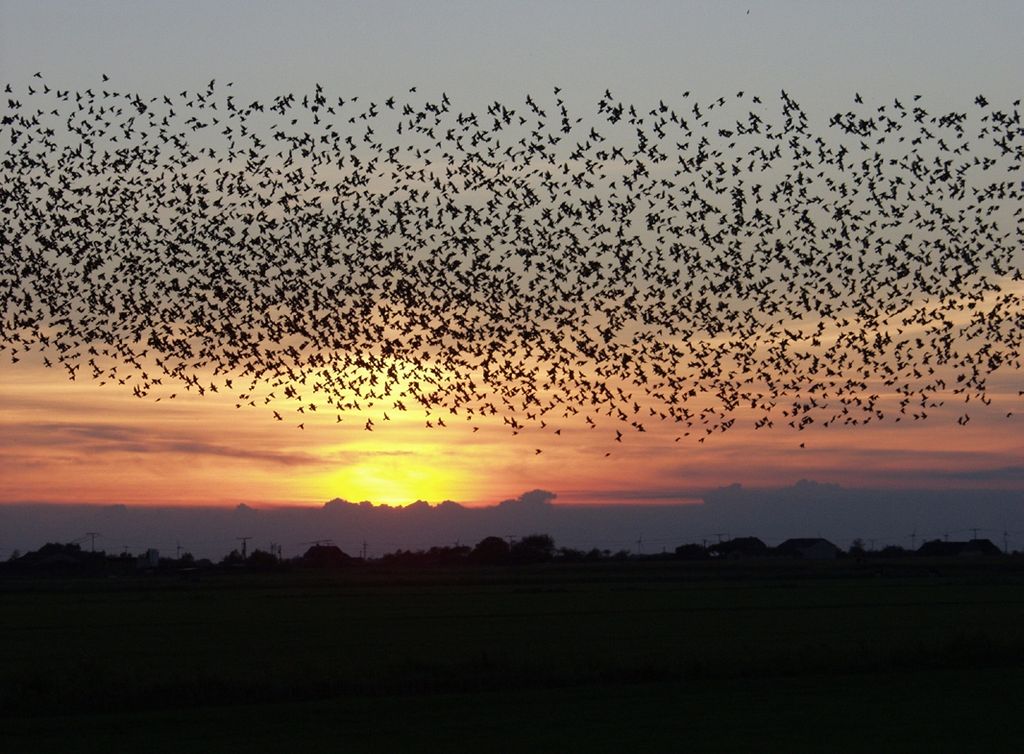 Birds are not perfectly adapted to all environments and sometimes a bird has to leave – migration. In its purest sense, migration refers to seasonal movements between a location where an individual or population breeds and a location where it survives during the non breeding period. Long-distance migrants are those that have a complete shift between the breeding and wintering areas, such as the Blackpoll Warbler that breeds in Canada; short-distance migrants, such as the Pine Warbler, make shorter trips, such as up and down the side of a mountain. Partial migrants are those species in which some individuals of a species leave and others stay, such as American Robins. Average distances covered are about 1000-3000 km each way, but 4000-6000 km is not uncommon.
Birds are not perfectly adapted to all environments and sometimes a bird has to leave – migration. In its purest sense, migration refers to seasonal movements between a location where an individual or population breeds and a location where it survives during the non breeding period. Long-distance migrants are those that have a complete shift between the breeding and wintering areas, such as the Blackpoll Warbler that breeds in Canada; short-distance migrants, such as the Pine Warbler, make shorter trips, such as up and down the side of a mountain. Partial migrants are those species in which some individuals of a species leave and others stay, such as American Robins. Average distances covered are about 1000-3000 km each way, but 4000-6000 km is not uncommon.
A migratory journey is usually broken into a series of short flights. Most songbirds migrate at night, singly or in loose flocks, and my cover 300-600km per night but they don’t fly every night and a 3000 km journey may take 3-4 weeks.
Birds might also have more than two migratory destinations. Anna’s Hummingbird, for example, breeds in the coastal chaparral and valley of California, summers in the high mountains, and winters in the deserts of Arizona and Mexico. Birds tend to migrate along four major routes in North America called flyways, depicted below.
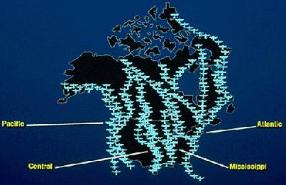
Recaptures of banded birds give us a lot of information as to where birds go and how long they live, but only a small % of banded birds are ever recovered. About 25% of banded ducks and geese are recovered because they are hunted, but fewer than .1% of songbirds are recovered. But even when a bird is recovered, we only know where it was banded and where it was recovered and how long it was in-between – not where the bird was in the meantime or how long it took it to get there.
We do know some things like the fact that a Semi-palmated Sandpiper flew 4000km in 26 days from Massachusetts to Venezuela – an average of 146km/day. A Lesser Yellowlegs banded in Massachusetts was recovered in the West Indies – 3000km or 600km per day. More recent studies with radio tracking give us some additional information.
Food Habits and Migration
There is often a relationship between food habits and migration. Insects become scarce in the winter in northern latitudes, so insectivorous birds must move closer to the equator where insects are more abundant. Insectivorous birds are the largest group of migrants. Some insect-eaters, such as chickadees, can eat seeds in the winter and thus do not tend to migrate. Fruit-eating birds may not have to migrate as far because fruits are generally available at the edge of the temperate zone. And seeds are available all year around in most areas, so seed-eaters tend not to migrate. But seeds are not produced in the winter and may be covered by snow, forcing birds southward, or at least down the mountains. By contrast, finches and crossbills that feed on pine seeds from the cones don’t have that problem and are non-migratory.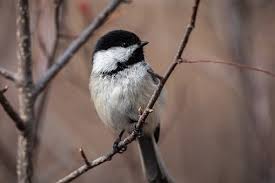
Fish-eating birds may be cut off from their food supply when northern lakes freeze over, but can generally overwinter if the lake doesn’t totally freeze over. Most aquatic birds winter at the edge of the temperate zone, but some go to the tropics. The most well-known of these is the Arctic Tern which migrates from the edges of the Arctic to the Antarctic and back again each year – a 22,000 mile round trip.
Large hawks which feed on mammals and birds tend to migrate because their prey either hibernates or migrates. In addition, photoperiod shortens and they have less time for hunting. Owls, on the other hand, don’t migrate as much (as a group) because the shortening photoperiod is not a major factor to them.
Geography and Migratory Behavior
There is more land area in the north temperate zone than there is in either the tropics or the south temperate zone; i.e. there is more potential breeding area than wintering area. There is even more contrast in habitat types; e.g. in the New World, the total amount of tropical forest in South and Central America is about equal to the total amount of forest in North America. But there is a limited amount of other habitat types in both areas. So a grassland species of North America must either winter in the southwestern US or northern Mexico, or fly all the way to Venezuela to find grassland. Wetland species- for example, shorebirds that nest in the marshes of the Arctic tundra – have no comparable habitat in the south and thus winter along the coastlines or travel all the way to the grasslands of Argentina.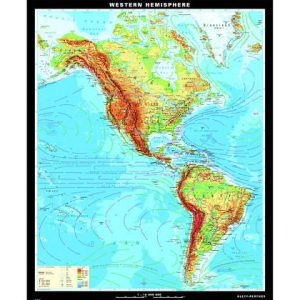
In the Old World, much of the northern land mass is forest or grassland, while most of Africa is desert and scrubland, only about 20% being tropical forest. Thus the birds that migrate have to adapt to living in a much different environment. But there are limits to this flexibility- a sandpiper can’t live in a rainforest. Australia, being relatively isolated by contrast, has relatively few migratory species – only 8% show north-south migrations. But 26% are nomadic– that is, they travel around the continent continually.
Although there is a large amount of tropical forest in South America, the vast majority of birds that migrate from North America to South America winter in central America , or the West Indies – very few actually go to northern South America or into the interior of South America.
Site Fidelity
If a bird returns to the same site each year, it must have some sort of genetically-based ability to remember the site and how to get there. For example, a young warbler may carry genetic information that causes it to remember its place of birth and then respond to cues that guide it to Puerto Rico. The young bird then spends the winter moving around, searching for a good place to stay. After overwintering, it returns north to the area of its hatching. The next year it returns to the same site in Puerto Rico. So the bird may spend its life in only a few hectares in two sites thousands of miles apart.
There must be a genetic basis to migration, because young birds that have never migrated before migrate successfully to their breeding grounds. In many shorebirds, the adults leave for their wintering grounds before the young, so the young have to know where to go without help.
Route Selection
Evolution of a migratory route is determined by many factors. Geographic or topographic factors are important for some species. But even some small warblers and hummingbirds have the ability to fly across the Atlantic Ocean on their way from North America to Mexico. But other species, such as some hawks and Turkey Vultures, follow the land route rather than crossing the ocean.Obviously, migratory routes have changed a great deal over geologic time; the glaciers of the ice ages advancing and retreating must have forced birds to change their routes, so migratory routes must have evolved like any other behavior to changing conditions.
Timing of Migration
The timing of migration is controlled by both proximate and ultimate factors. Ultimate factors are evolutionary and proximate factors are cues.
Resource and Breeding Factors -ultimate factor that determines the suitability of the breeding and wintering grounds. Breeding sandpipers must arrive early in the year in the Arctic as soon as the snow clears so that they have enough food and sufficient time to raise their young before fall.
Climatic Factors – ultimate factor that determines food supply and survivability on the breeding or wintering grounds, but also a proximate factor that influences the timing of migration. Bad weather, rain, and heavy winds may cause birds to fly faster or slow them down. In the Northern Hemisphere, high pressure systems have winds that blow clockwise around them and low pressure systems have counterclockwise winds. So if there is a high pressure system (causing winds to blow from the north), followed by a low pressure system (causing winds to blow from the south), the birds will wait until the low pressure system starts to blow and get a tail wind on their way north. That’s why there are often “waves” of migrants. Birds take about 24 hours to cross the Yucatan Peninsula to the US nonstop; with a tail wind this can be reduced to 20 hours. If the wind should switch direction, it could slow the birds down enough that they die enroute.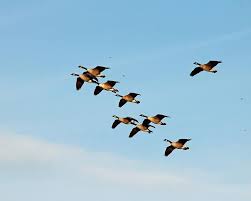
Photoperiod Clues – this is a proximal cue that tells the birds when to migrate. If the birds depended merely on the weather, they could leave too early and be caught with bad weather later or no food in their breeding site; if the weather is bad and they left too late, they would be outcompeted. So they depend on the photoperiod for timing as photoperiod is very predictable and, on the average, is most beneficial for migration.
Without going into a lot of detail here, I have to note that migratory behavior is not only tied to photoperiod, but hormones, gene expression, behavior, and the reproductive cycle. A very good explanation of all this is a paper entitled Hormones in Migration and Reproductive Behavior in Birds by Marilyn Ramenofsky.
Navigation and Orientation
How does a bird find its way? We can learn some things about the navigation and orientation behavior of birds through observation or through banding, but the best information has come through experiments.
Species vary in their navigational abilities. Some birds have the ability to find their way back if they are displaced. Homing pigeons are pretty good at this and the most impressive was a Manx Shearwater, taken from its burrow on the Atlantic coast and flown to England by commercial aircraft, returned to the burrow in 12.5 days.
Most early studies on navigation tried to explain it by one mechanism. But now we know that birds use several mechanisms.
Landmarks. There is some indication that birds use landmarks, at least sometimes. Homing pigeons taken 200 miles off the coast of France in the middle of the Atlantic – only 2% returned home. But in other studies, pigeons were fitted with nearly opaque contact lenses – so they could could see light, but nothing else, and most found their way home (but had a hard time landing). And, of course, birds that navigate at night cannot see landmarks.
Solar Cues. The position of the sun seems to be one of the prime navigational cues for both nocturnal and diurnal fliers.
In the 1950s, Kramer put Starlings in cages with opaque walls and a glass top. He found that on sunny days, they oriented in the appropriate direction, but on cloudy days they oriented randomly. Bellrose, working with Blue-winged Teal, fitted them with radio transmitters and found that on cloudy days, they would circle until they got above the clouds at which time they started to move in the appropriate direction.
Using the sun as a compass requires compensating for its movement across the sky, which birds seem to be able to do by setting their internal biological clocks. One experiment with homing pigeons kept pigeons under artificial light until their biological clock was six hours off from the actual local time. When released, they flew 90 degrees off from the proper direction. This internal clock is called a “sun compass”.
Radio- tagged Blue-winged Teal were noted to circle under a cloudy sky until they got above the clouds and then headed in the proper direction, indicating that they need to see the sun to navigate. Even nocturnal birds seem to take their cue from the sun as cloudy days either result it no migration at night or the migrants show an unusual variation of direction.
Stellar Cues. Cues provided by the stars are obviously important only to nocturnal migrants. To determine the importance of stellar cues in orientation, birds were put in cages outside with a view of the night sky to see which way they oriented.
But the most sophisticated experiments put these birds not under the normal night sky, but in a planetarium. This way, the sky could be changed and the birds’ response to the moving sky could be measured.In a classic experiment by a German ornithologist, Sauer, in the 1950’s, warblers were put into cages in a planetarium in the fall. The birds oriented in a certain direction and Sauer moved the night sky in that direction (at a normal speed) about 300 Km, the distance the birds would normally move in a night. The next night he did the same thing – move the sky in the direction the birds were oriented. At the end of a couple of weeks, the birds quit showing their restlessness as they had migrated to the night sky that showed middle Africa, where they would have gone if they were free. Not only that, they migrated around the Mediterranean sea enroute. All by stars.
Experiments by Emlen in 1975 showed that the Indigo Bunting seem to use the northern sky within about 35 degrees of the north star, for most of their navigation.
Geomagnetic Cues. Geomagnetism is perhaps the most controversial and least understood of the major possible navigational cues. Early studies by Merkel and Wiltschko (1964) placed birds in a large cement cage with no environmental clues at all; the birds oriented properly. But when they were put in a large steel cage, which would obviously affect magnetic lines of force around the cage, the birds oriented randomly.
The best studies have been done by Keeton in the 1970’s with homing pigeons.When brass bars were attached to pigeons, they generally oriented themselves in the direction of home from an unfamiliar location, whether it was a sunny or overcast day. When a magnetic bar was attached to the pigeons, they did about the same on a sunny day, but were disoriented on an overcast day – the magnet seemed to have thrown them off when they had no sun to orient by. A more sophisticated experiment was done later with Helmholtz coils. The coils produced a magnetic current around the birds’ heads. The current could either flow in a clockwise direction (normal direction of the magnetic field in the northern hemisphere), in which case the birds flew directly home on either a cloudy or sunny day; or the current could be made to go counterclockwise- in this case the birds flew directly home on a sunny day, but flew 180 degrees in the wrong direction on an overcast day. These experiments demonstrate two things: that geomagnetic lines of force do seem to be used for orientation and that the sun compass is the dominant navigation mechanism.
Thus orientation and navigation may be due to a variety of cues. There is some evidence that odors may play a role in navigation, or even sounds (ocean waves, waterfalls).
Thank you………….for a senior citizen who loves birds and is fascinated by their very existence, you have helped me make a Humongous leap in my understanding of how, when, why, where migration/navigation takes place.
Excellent, very understandable and pleasurable reading……………
Thank you for sharing this knowledge…………..
Very Grateful,
Mary
It is of great interest for me how birds navigate.
Thanks it help me in understanding